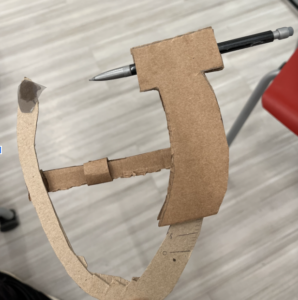We discussed all of our ideas from concept generation as a group, and combined similar themes and functionalities until we were left with two distinct designs: a standalone ALLR drill guide and a 2-in-1 ALLR and ACLR drill guide. Through discussion and low fidelity modeling, we came to the conclusion that both concepts were seemingly capable of achieving our main design goal of alleviating tunnel conflict which meant that both concepts were worthy of development and testing. We broke off into two design teams to discuss and refine these concepts further, leading to the OASIS and DUNE sub-team structure we employed for the alpha prototype.
The idea behind the Dune prototype was to add to a tool that is already commonly used in operating rooms for the ACLR surgery. This idea came to fruition from an interview with one of our stakeholders, orthopedic surgeon Dr. John Grant. During this interview, he stated that it would be ideal to drill the ACLR and ALLR tunnels with direct reference to each other to ensure they do not converge. This gave way to the 2-in-1 drill guide concept that was deployed in our Dune model.
We started by making a cardboard model of a FlipCutter® drill guide system. This allowed us to visualize the problem in 3D space. From here, our sub-team discussed ideas for an add-on mechanism that would position an ALLR tunnel to avoid convergence with the ACLR tunnel. We had several abstract ideas for add-ons that had the potential for achieving our goal. These ideas consisted of a bar across the flip-cutter with one point of attachment, a bar across the handle with two points of attachment, and an add-on that drops below the handle. We knew that we needed a mechanism that would allow us to drill a hole in a location and a trajectory that avoids the ACLR tunnel. We were able to confidently visualize the ACLR tunnel through extensive research on ACLR surgery and through the use of low fidelity modeling. After deliberation and compiling research on the ACLR surgery, we came to the conclusion that a bar fixed across the middle of the FlipCutter® with two points of attachment would most easily and consistently allow us to reach the location and trajectory needed to avoid tunnel convergence. We also knew that we wanted to have as many degrees of freedom as possible in order to confirm whether or not our concept was capable of alleviating tunnel convergence. In order to have maximum freedom, we designed an L-tube and T-tube mechanism that was capable of rotating freely about two axes. We agreed that the cross-bar with a sliding L-tube and T-tube mechanism to guide the drill would allow for the degree of freedom that could likely result in the ability to drill an ALLR tunnel without conflicting with the ACLR tunnel. This bar concept was modeled with cardboard and added to the low fidelity FlipCutter® model. This model is pictured below.

Using the low fidelity model, we began sketching the Dune prototype on Fusion 360. This phase of prototyping resulted in several alterations to the size and shape of our design due to 3D printing specifications. For example, the initial drawing was wider than the plate of our 3D printer. This meant that it could not be printed. We decided to try to cut the piece in order for it to fit on the plate. However, when we made the initial cut, the curve was still too wide to print successfully. We were then faced with the decision to cut it into three parts, which would significantly weaken the design, or to redesign it entirely. We decided to redesign the part (mainly just scaling down all dimensions to 0.75 times the original) to ensure structural integrity during testing and printability. Ultimately, the process resulted in a prototype that was capable of progressing to the testing phase.